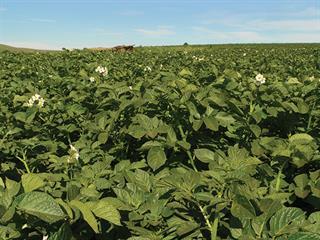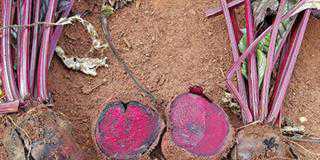
Potatoes and carrots can be difficult to grow profitably on a small commercial scale. Both require a certain amount of mechanisation, and you have to sell large quantities to make this pay for itself. But small farmers in rural areas can still make a profit by selling potatoes directly to the community.
Saving on market costs and transport can make up for some of the disadvantages of not having mechanisation. At the simplest level, you can dig the planting furrows by hand. To do this, place a string along the first planned furrow. Then, using a hand hoe, scrape soil from the string to one side. Remove the string and scrape the soil to the opposite side to form a furrow. Create furrows 1m apart to finish the area.
READ MORE: Producing award-winning potatoes
If you have a tractor, draw furrows with a plough with double mouldboard that throws up soil on either side of a central furrow. The spacing should be wide enough so that you can drive the tractor between the furrows to close the planted potatoes and ridge the crop. (This will be covered in the next issue.)
Small potatoes and saving money
One of the big outlays of potato growing is the cost of seed potatoes. These are expensive because extra care has to be taken to ensure they are disease-free. However, if you’re starting off on a small scale, there is not too much risk in buying small potatoes and using these for planting. I sometimes come upon a tasty variety but cannot find small quantities of certified seed for it. In this case, I simply buy small potatoes of this variety. As long as the tubers are clean and healthy, they are usually fine.
Speeding up sprouting
The potatoes used for planting must have started sprouting. If not, they will take too long to emerge and may grow unevenly. Certified potatoes will usually be on the verge of sprouting. You can speed up the process of sprouting by covering the potatoes with a layer of moist compost. Alternatively, moisten them and place them on the floor in a shed. When the eyes start sprouting, plant them. Don’t let the shoots get too long or you risk breaking during planting. Also, keep an eye out for rats while waiting for the potatoes to sprout – they are attracted to potatoes.
READ MORE: The risks of nematodes in potatoes
The planting season will vary according to the area. In a frost-prone area, you can safely plant the potatoes a few weeks before the frost is due to end, as the shoots will take a while to emerge from the soil. In any case, frost is unlikely to damage the sprouts too badly. In sub-tropical climates, April/May is a good time to plant. Planting in the heat of summer in hot areas will not be successful.













